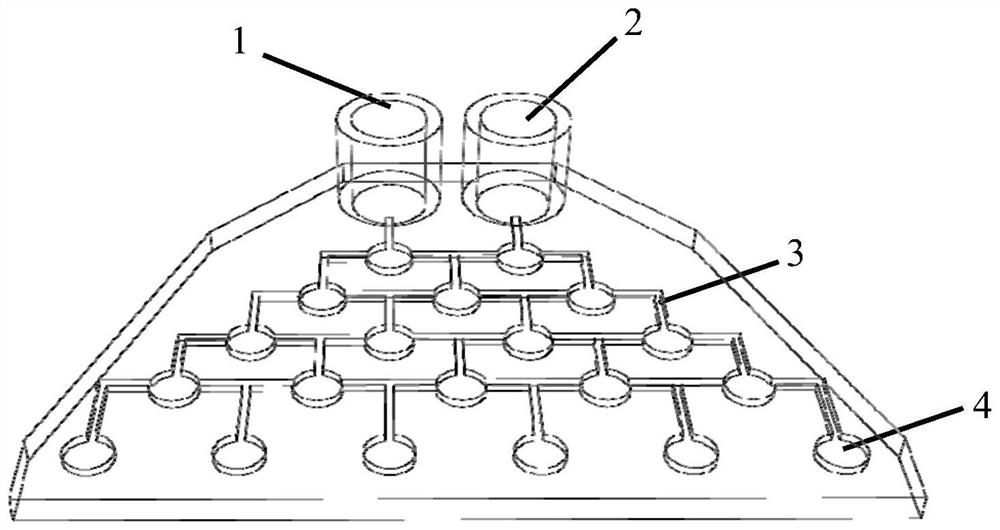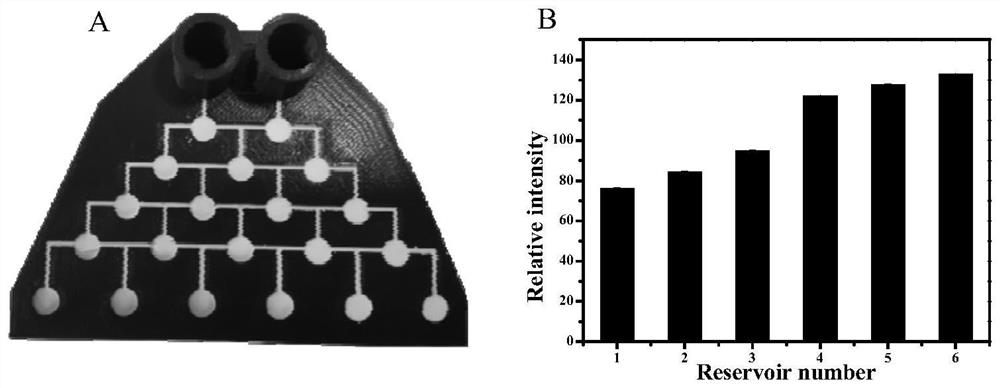3D printing concentration gradient chip for research of model for improving HepG2 insulin resistance by pioglitazone
A technology of insulin resistance and concentration gradient, which is applied in the fields of medicine and engineering, can solve the problems that mass production cannot be realized, and the microfluidic gradient generator is out of the laboratory, etc., and achieve the effect of low reagent consumption
- Summary
- Abstract
- Description
- Claims
- Application Information
AI Technical Summary
Problems solved by technology
Method used
Image
Examples
Embodiment 1
[0029] Dilute the blue ink stock solution by 200 times, inject 1 ml of blue ink diluent into the first injection port 1 of the chip, and inject 1 ml of deionized water into the second injection port 2 at the same time, keep the pressure on both sides balanced, relying entirely on Capillary action was used to mix and transport the solution, and after a stable colorimetric gradient was formed, ImageJ was used to analyze and process the change in color intensity.
[0030] Such as figure 2 As shown in A, the color gradient of the entire chip is very obvious. At the final outlet, the blue color gradually becomes lighter from left to right, and the far right end is colorless, which confirms the generation of concentration gradient; due to the surface morphology of α-cellulose powder Relatively orderly, the color of the chip is uniform, and there is no obvious coffee ring reaction. processed by ImageJ figure 2 In B, the change of the relative gray value is consistent with the cha...
Embodiment 2
[0032] A method of cell culture in a 3D printed concentration gradient chip for the study of pioglitazone improving HepG2 insulin resistance model is as follows:
[0033] Digest the cells in logarithmic growth phase, count and dilute to 4×10 5 / ml, add the same volume of hydrogel solution to dilute to 2×10 5 / ml, 30 μL of cell suspension per well was inoculated into the circular cell culture pool 4 of the concentration gradient chip, at 37 °C, 5 % CO 2 cultured in an incubator.
[0034] Such as image 3 Shown is the confocal three-dimensional characterization reconstruction of cells cultured in hydrogel. It can be observed that the green fluorescent protein-labeled HepG2 cells are suspended in the middle of the hydrogel medium, and the cells can fully contact each other, and can be passed through The hydrogel transmits signal molecules to distant cells, and the living space of the cells grows exponentially, which is a multi-layer culture method; the cells are evenly distrib...
Embodiment 3
[0036] A method for establishing an insulin-resistant cell model in a 3D-printed concentration gradient chip for the study of pioglitazone improving the HepG2 insulin-resistant model is as follows:
[0037] Digest the cells in the logarithmic growth phase, count and dilute to 4×10 5 / ml, add the same volume of hydrogel solution to dilute to 2×10 5 / ml, 30 μL of cell suspension per well was inoculated into the circular cell culture pool 4 of the concentration gradient chip. After the cells were cultured for 24 h, the medium was aspirated, and a concentration of 1×10 was added to the first injection port 1 of each chip. -5 and 1×10 -7 μmol·L -1 insulin solution. After insulin was co-cultured with the cells for 24 h, 10 μL of the cell culture medium was drawn from each well for ELISA experiments to detect the glucose consumption rate.
[0038] Such as Figure 4 It was shown that under the action of insulin, the level of glucose consumption by cells decreased in a dose-depe...
PUM
 Login to View More
Login to View More Abstract
Description
Claims
Application Information
 Login to View More
Login to View More - R&D
- Intellectual Property
- Life Sciences
- Materials
- Tech Scout
- Unparalleled Data Quality
- Higher Quality Content
- 60% Fewer Hallucinations
Browse by: Latest US Patents, China's latest patents, Technical Efficacy Thesaurus, Application Domain, Technology Topic, Popular Technical Reports.
© 2025 PatSnap. All rights reserved.Legal|Privacy policy|Modern Slavery Act Transparency Statement|Sitemap|About US| Contact US: help@patsnap.com



